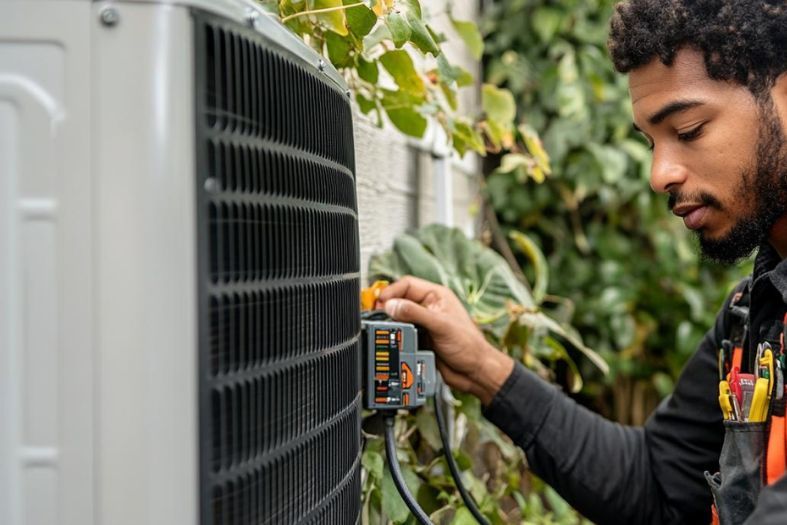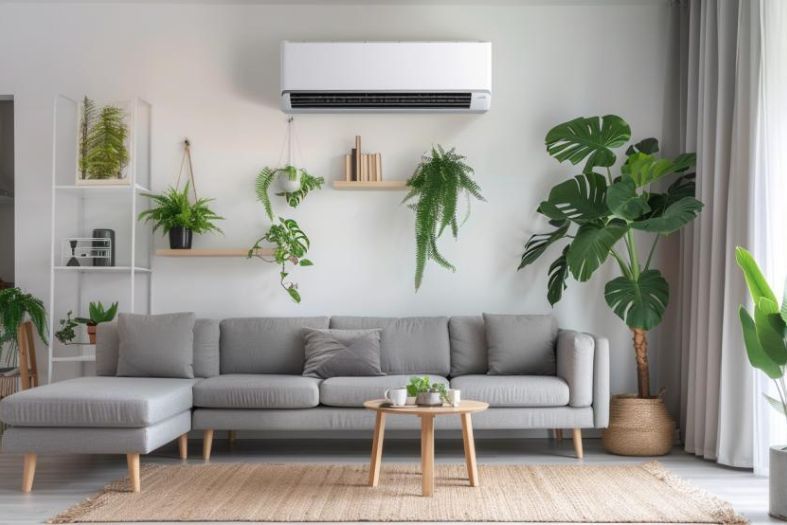What is the Average Cost of Furnace Installation in Flowery Branch, GA?
The average cost of furnace installation in Flowery Branch, GA, typically ranges from $2,500 to $6,000, depending on the type of furnace, complexity of the installation, and any additional modifications needed. Factors such as the size of your home and the specific features of the furnace can also influence the final price.
Having a new furnace installed in your Flowery Branch home will require a significant investment. Choosing the right type of furnace will help you avoid additional costs or higher bills. In this article, we’ll break down the average furnace installation cost in Flowery Branch, considering factors such as fuel type, energy efficiency, and installation complexities.
Whether you’re leaning towards an electric, natural gas, or oil furnace, we’ll explore how each option affects the price and what to expect in terms of upfront costs and long-term savings. Once you understand the costs of everything that goes into the installation, you’ll be better equipped to make an informed decision for your home.
How Furnace Type Affects Installation Costs
All types of furnaces serve the same essential purpose of heating your home. They are powered by different fuel sources, and each type has its own price range and efficiency level. Your options include electric, natural gas, and oil furnaces.
Electric furnaces are budget-friendly upfront but may lead to higher energy costs. Natural gas furnaces offer a good balance of efficiency and warmth, making them ideal for colder areas. Oil furnaces are a safer, longer-lasting option, though they come with higher maintenance and fuel expenses. Your choice depends largely on your heating needs, local climate, and budget.
Electric Furnaces
Electric furnaces are generally the most affordable to install, with costs ranging from $1,800 to $7,300, including installation. These systems use heating coils to warm up the air, which is then circulated through ducts to heat your home.
While electric furnaces efficiently convert electricity into heat, they consume a lot of power. This makes them more suitable for areas with mild winters, like Flowery Branch, where the heating demands are lower.
One key advantage of electric furnaces is that they tend to be easier and cheaper to maintain than other types. However, you may see higher utility bills due to their electricity consumption.
Natural Gas Furnaces
The price for a natural gas furnace can go up to $9,500 with included installation. The initial cost may be higher if you opt for a high-efficiency model, but the savings on energy bills over time can make it a worthwhile investment. Natural gas is an ideal choice for colder climates since it generates heat that feels warmer and is more consistent than electric heat.
In Flowery Branch, where winters are generally moderate, a natural gas furnace can be a great option for those who want faster, more robust heating. However, remember that natural gas systems require more complex installation, which can add to the cost.
Oil Furnaces
Oil furnaces are less common in Flowery Branch but remain popular in regions with severe winters, like the Northeast. You’re looking at $4,500 and $8,000 if you want to buy an oil furnace and have it installed. Due to the price of oil, they come with higher ongoing expenses. In terms of efficiency, oil furnaces lag behind natural gas and require more regular maintenance.
On the upside, oil furnaces are considered safer since there’s no risk of carbon monoxide leaks or explosions, which can be a concern with gas. Additionally, they have a longer lifespan when well-maintained, often lasting up to 20 years or more. If you’re considering an oil furnace, it’s important to factor in both the upfront installation cost and the ongoing expense of maintaining and fueling the system.
How Furnace Size Impacts Installation Costs in Flowery Branch
The size of a furnace significantly influences its installation cost, just as it does with air conditioning systems. Furnace size is measured in British Thermal Units (BTUs), determining the amount of heat the system can produce. To find the right size for your home, you can estimate by multiplying the square footage of your space by 40.
In general, smaller furnaces, such as those with 40,000 to 60,000 BTUs, will cost between $2,000 and $3,000 to install. For a moderately sized home of around 1,500 square feet, a 60,000 BTU furnace is typically priced around $3,000. If your home is larger, around 3,000 square feet, you may need a furnace with up to 120,000 BTUs, bringing the cost up to about $6,000.
Additionally, homes with cathedral ceilings or drafty windows and doors may require more powerful systems to ensure that the space is adequately heated, which could increase the cost. For example, a 2,500-square-foot home might need a 100,000 BTU furnace, pushing the price to roughly $5,000.
Before buying a furnace, consult an HVAC professional to assess your home’s needs, including factors like ceiling height, insulation quality, and overall layout. This ensures you choose a furnace that provides efficient heating without overworking or underperforming, helping to maintain both comfort and energy efficiency.
How Efficiency Impacts Furnace Installation Costs
Furnaces that operate more efficiently may initially come with a higher price tag, but the benefit is the ongoing reduction in energy bills. The more efficiently a furnace converts fuel into heat, the less energy it wastes, ultimately saving you money over time.
For instance, high-efficiency furnaces are more expensive than standard models but can help you save on utility bills. A furnace with a higher Annual Fuel Utilization Efficiency (AFUE) rating means less energy is lost during operation.
So, while you pay more upfront for a high-efficiency furnace, you’ll see a return on investment through lower monthly energy costs. For example, a natural gas furnace that operates at 95% efficiency may cost more than a standard 80% efficient model but will help cut down on heating expenses during cold months.
To estimate how much you could save with a more efficient furnace, consider the difference in efficiency between your new and old unit. For example, if your new furnace is 25% more efficient than the one you’re replacing, you could multiply that percentage by your average monthly heating bill. If your current bill is $200, upgrading to a more efficient furnace could save you around $50 monthly.
How Labor Costs Affect Furnace Installation in Flowery Branch
How much you have to pay for a contractor to install a new furnace will depend on their expertise and the job’s complexity. Typically, HVAC professionals charge between $75 and $150 per hour for furnace installation, which usually takes 4 to 8 hours to complete. This means labor alone could add anywhere from $300 to $1,200 to your overall furnace replacement cost.
Although labor costs are often included in the total price estimate for furnace installation, it’s a good idea to ask your contractor for a detailed breakdown. This will help you understand what you are paying for. For instance, installing a more complex system or adjusting your ductwork could extend the time it takes to complete the job, potentially raising labor costs.
To avoid surprises, always request a comprehensive estimate that covers labor, materials, and any required permits.
How Tax Credits Can Reduce Furnace Installation Costs
With government tax credits, you can offset some of the costs associated with installing a new furnace. Under current tax laws, you can get a non-refundable tax credit to install an oil or gas furnace. This means that when you file your taxes, you could potentially get back a portion of what you spent on your new furnace, making the overall expense more manageable.
However, tax laws frequently change, so you should verify whether your installation will still be eligible for these credits when you’re ready to replace your furnace. It’s a good idea to consult with your furnace installer and an accountant to ensure your new system qualifies. High-efficiency models are often the most likely to earn tax credits, so choosing an energy-efficient furnace could lower your utility bills and provide extra savings come tax season.
Top Furnace Installation Service in Flowery Branch, GA
Adding a new furnace to your home can be a significant investment that requires some budgeting. By understanding everything that impacts the costs, you can make a more informed decision and ensure your household can afford to make the investment.
Whether you’re upgrading to a more efficient model, ensuring your home stays comfortable during cold months, or looking to take advantage of energy-saving incentives, knowing what to expect will help you a lot.
If you’re ready to install a new furnace or need expert advice on the best heating solution for your home, trust the professionals at Gee Heating and Air. We have over 30 years of experience with furnace installation, repair, maintenance, and replacement with high-quality equipment. Contact us today to schedule a consultation and keep your home warm all winter!
FAQs
What’s the best type of furnace for Flowery Branch, GA?
Natural gas furnaces are often a popular choice for homes in Flowery Branch due to their efficiency and ability to handle colder weather. However, electric furnaces may be a better option if you’re looking for a lower upfront cost and live in a milder climate.
Are there any tax credits available for furnace installations?
You can get a non-refundable tax credit to install a new oil or gas furnace in your home. However, you should consult with your furnace installer and an accountant to confirm eligibility.
How often should I replace my furnace?
If your furnace is over 15 years old, requires frequent repairs, or no longer heats your home efficiently, it may be time to consider a replacement.









